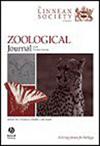Novel molecular data for diplozoids reveal similar mitochondrial and ribosomal phylogenies, unexpected geographical structure, and intra-individual mito-nuclear incompatibilities
IF 2.8
2区 生物学
Q1 ZOOLOGY
引用次数: 0
Abstract
Diplozoids are parasitic flatworms known for their unique development, whereby two hermaphroditic individuals fuse to form a single adult. They exhibit varying host specificity, with Paradiplozoon homoion having the widest known distribution, making it a suitable model for population genetic studies. In this study, the genetic variability of P. homoion was assessed from 60 cyprinoid fish species at 47 sites in the western Palaearctic using the mitochondrial COI gene. Moreover, novel sequence data of four ribosomal and one mitochondrial marker were used to understand phylogenetic relationships among diplozoids. A total of 29 unique COI haplotypes in six divergent haplogroups among P. homoion populations were identified. The COI fragment showed ≤8.8% intraspecific variability. The Caspian Sea Basin and Anatolio-Mediterranean region had the highest haplotype diversity, while the Danube Basin and western Europe populations had similar haplotypes. Phylogenetic analysis showed congruence between mitochondrial and ribosomal markers, except for Paradiplozoon koubkovae from Iran. The high intraspecific variability highlights the rapid mutation rate in mitochondrial DNA, important for future taxonomic studies. The spatial distribution of mitochondrial DNA haplotypes showed partial geographical structure, suggesting an east-to-west dispersal route for P. homoion into Europe. The presence of different haplotypes within a single individual suggests intraspecific hybridization.新的二倍体分子数据揭示了相似的线粒体和核糖体系统发育,意想不到的地理结构,以及个体内核分裂不相容
二倍体是一种寄生扁虫,以其独特的发育而闻名,两个雌雄同体的个体融合形成一个单独的成虫。它们表现出不同的宿主特异性,其中异plozoon homoion具有最广泛的已知分布,使其成为群体遗传研究的合适模型。本研究利用线粒体COI基因对古北西部47个地点的60种鲤科鱼类进行了遗传变异分析。此外,利用4个核糖体和1个线粒体标记的新序列数据来了解二倍体之间的系统发育关系。在6个不同的单倍群中,共鉴定出29个独特的COI单倍型。COI片段显示出≤8.8%的种内变异。里海盆地和安纳托利亚-地中海地区种群的单倍型多样性最高,多瑙河盆地和西欧种群的单倍型多样性相似。系统发育分析显示,除了伊朗的kubkovae副plozoon外,线粒体和核糖体标记是一致的。高种内变异性突出了线粒体DNA的快速突变率,这对未来的分类学研究很重要。线粒体DNA单倍型的空间分布呈现出部分地理结构,提示非洲狮进入欧洲有一条由东向西的传播路线。单个个体中存在不同的单倍型表明存在种内杂交。
本文章由计算机程序翻译,如有差异,请以英文原文为准。
求助全文
约1分钟内获得全文
求助全文
来源期刊
CiteScore
6.50
自引率
10.70%
发文量
116
审稿时长
6-12 weeks
期刊介绍:
The Zoological Journal of the Linnean Society publishes papers on systematic and evolutionary zoology and comparative, functional and other studies where relevant to these areas. Studies of extinct as well as living animals are included. Reviews are also published; these may be invited by the Editorial Board, but uninvited reviews may also be considered. The Zoological Journal also has a wide circulation amongst zoologists and although narrowly specialized papers are not excluded, potential authors should bear that readership in mind.

 求助内容:
求助内容: 应助结果提醒方式:
应助结果提醒方式:


